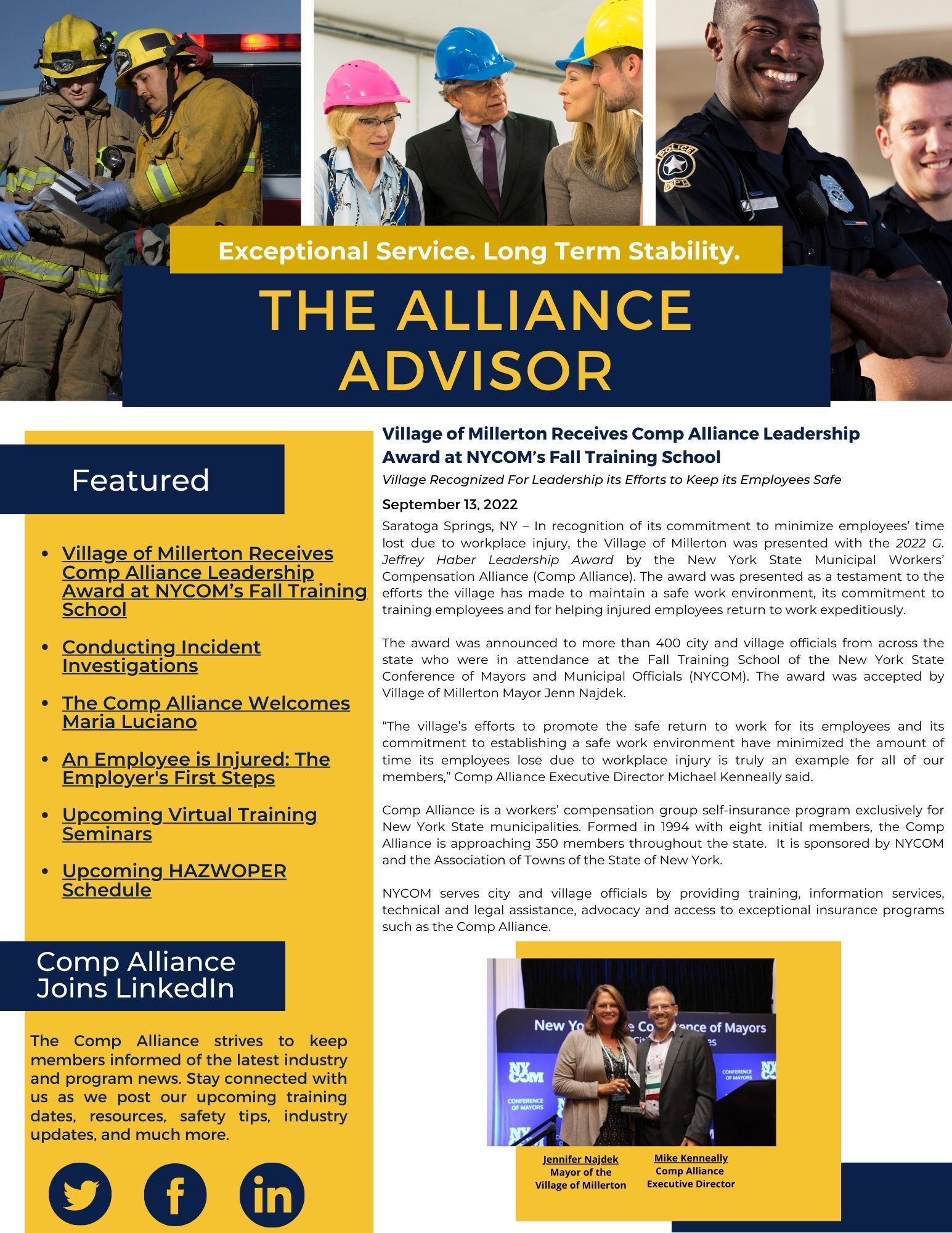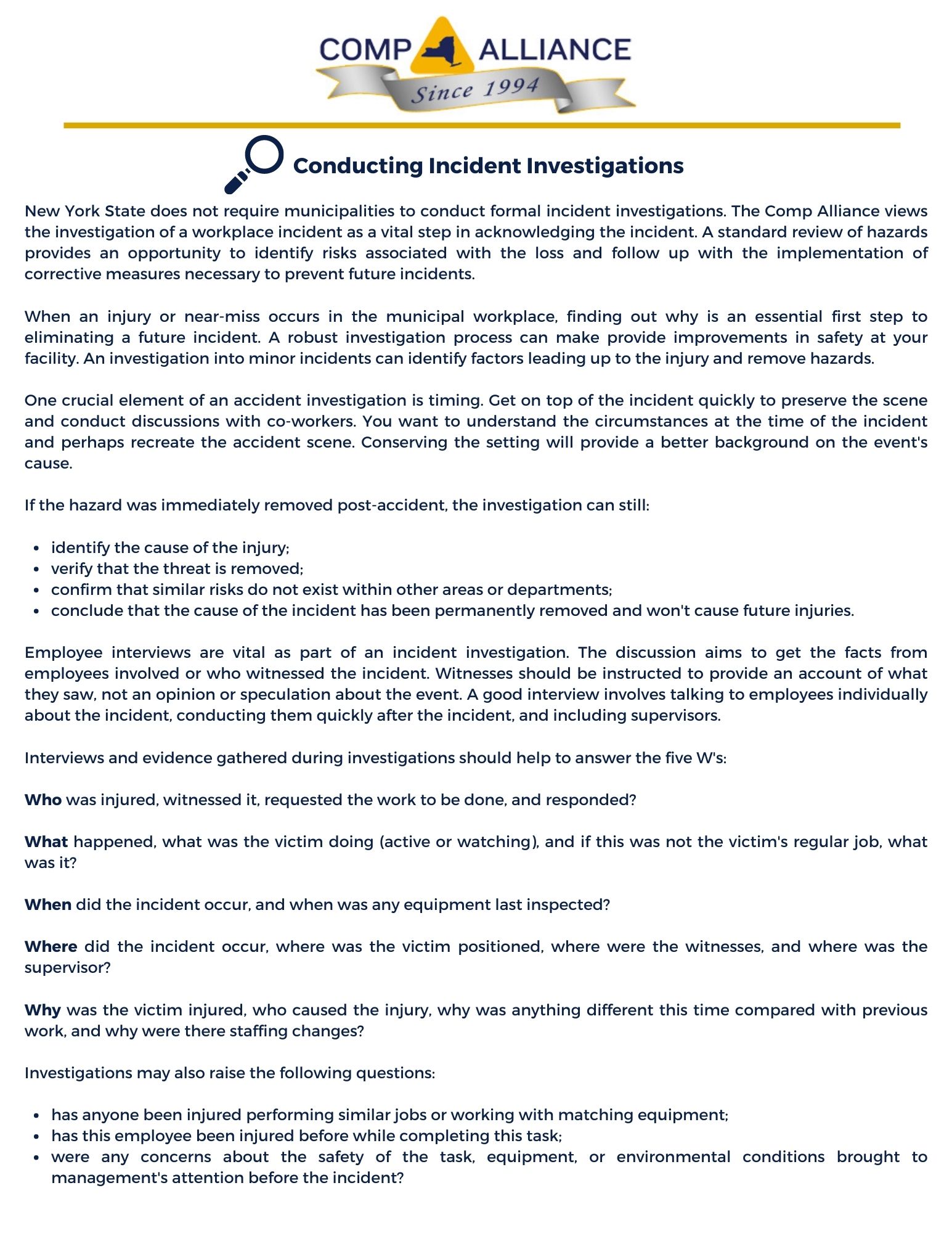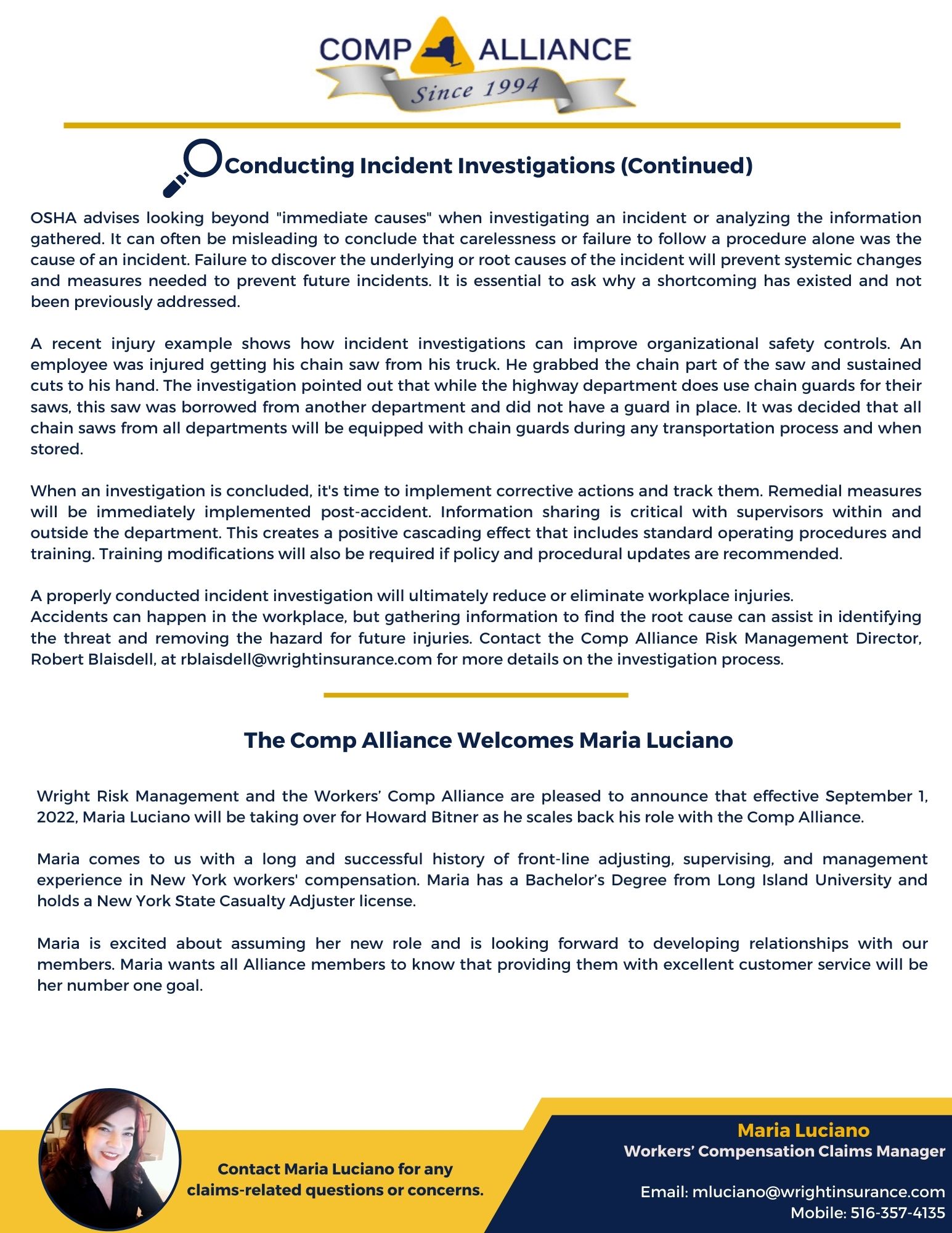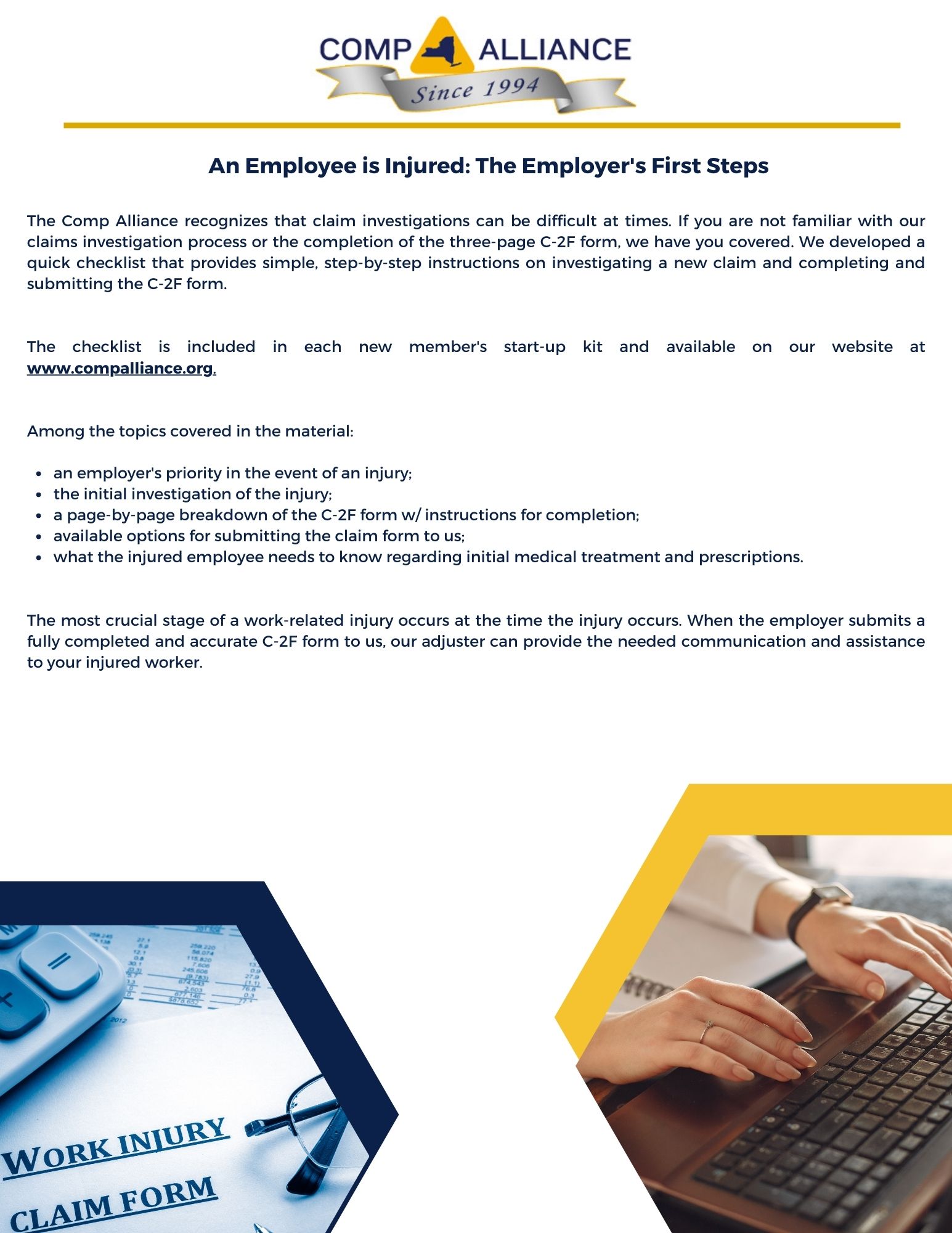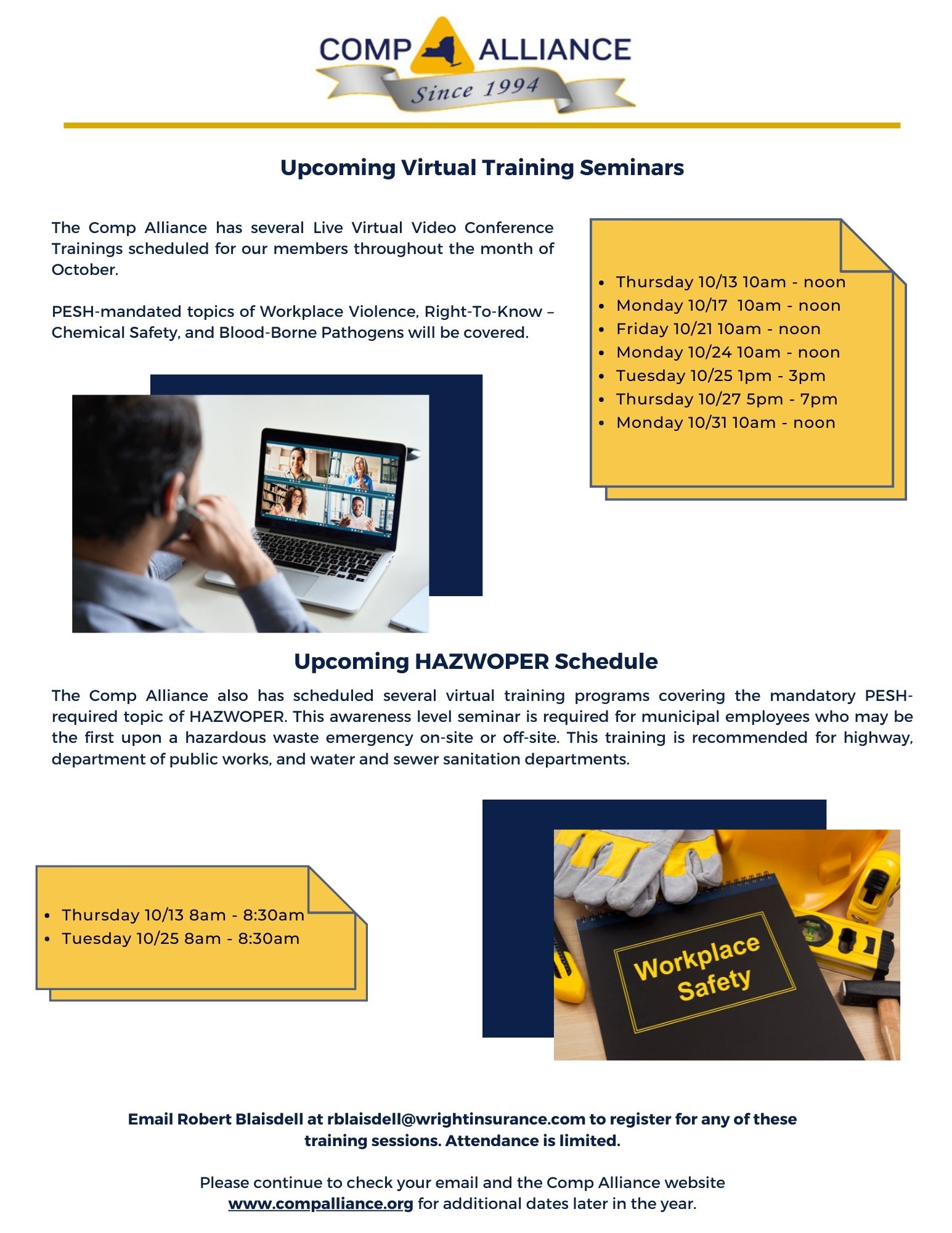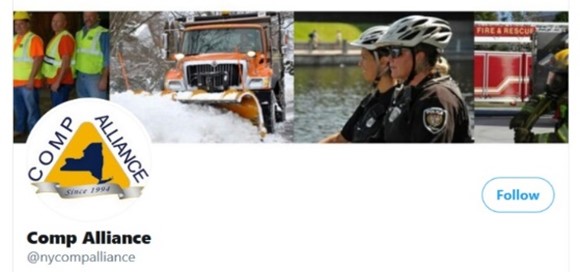The Safe Workplace Award Program is a monetary award provided to the safest workplaces in New York State. We are pleased to announce New York State Municipal Workers’ Compensation Alliance (Comp Alliance) Safe Workplace Award for eligible members during policy year 2021.This award benefits Comp Alliance members who have had positive loss experience and contributed to the financial well-being of the program during a given policy year.
The Comp Alliance Board of Trustees appreciates its members that continue to perform well and have contributed to its continued success. As a result, distribution of nearly $450,000 will be sent to the qualified January renewal members for their performance during the 2021 policy year.
If your municipality qualifies, you will receive your check in person or by mail. For questions on eligibility, please contact your Comp Alliance Marketing Representative, This email address is being protected from spambots. You need JavaScript enabled to view it..
As the Comp Alliance continues its history of predictable rates and financial stability, we are proud to be in a position to give back to the members. In the past four years, the Comp Alliance has distributed annual Loyalty Award checks and Safe Workplace Awards.
The Comp Alliance Board of Trustees will continue to evaluate the program's financial condition on an annual basis and determine eligibility for the program going forward.
A large majority of municipal operations have departments where heavy equipment is being operated by staff. All heavy equipment requires trained personnel to operate them safely and contribute to an injury-free workplace.
Recent events have resulted in tragic outcomes for highway and public works environments. Earlier this year, a forklift operator was killed when he was pinned between the rear of the forklift and a metal rack he was working on. The cause of the loss was the forklift being driven by an untrained worker who was unfamiliar with the safe operations of the forklift. This example emphasizes the requirement to have staff be properly trained.
Another recent example resulting in a tragic loss of life, a truck driver/equipment operator was loading an excavator onto a low-boy trailer when the excavator slipped off the side of the trailer, crushing the operator as he was ejected from the seat. The cause of this incident included the operator’s apparent ejection from the excavator onto the ground where the excavator rolled over. The operator was not wearing a seatbelt while moving the excavator and there was no spotter to assist with the loading process.
Unfortunately, there are other examples of equipment operators being injured or killed in the workplace around heavy equipment. Accidents like these include roll-over events, striking loader buckets, falling debris, etc. The key to reducing or eliminating such injuries is training on the safe operation of the equipment and using situational awareness. Only properly trained and knowledgeable staff should be permitted to operate heavy equipment such as loaders, excavators, forklifts, graders, rollers, and others. When untrained staff attempt to maneuver these large and powerful machines, workplace injuries are likely to result.
The causes of loss for most incidents involving heavy equipment are related to untrained or inexperienced operators. Proper training on equipment will educate workers, help prevent future incidents, and provide situational awareness.
For additional information contact:
Robert Blaisdell
Director of Loss Control
Email: This email address is being protected from spambots. You need JavaScript enabled to view it.
Phone: (518) 330-8591
The Comp Alliance is always looking for ways to improve school safety culture through loss control inspections, training, safety committee participation, and safety bulletins. With the start of the school year just a few days away, now is a great time to talk about safety for your school staff, including teachers, maintenance, custodians, coaches, and bus drivers.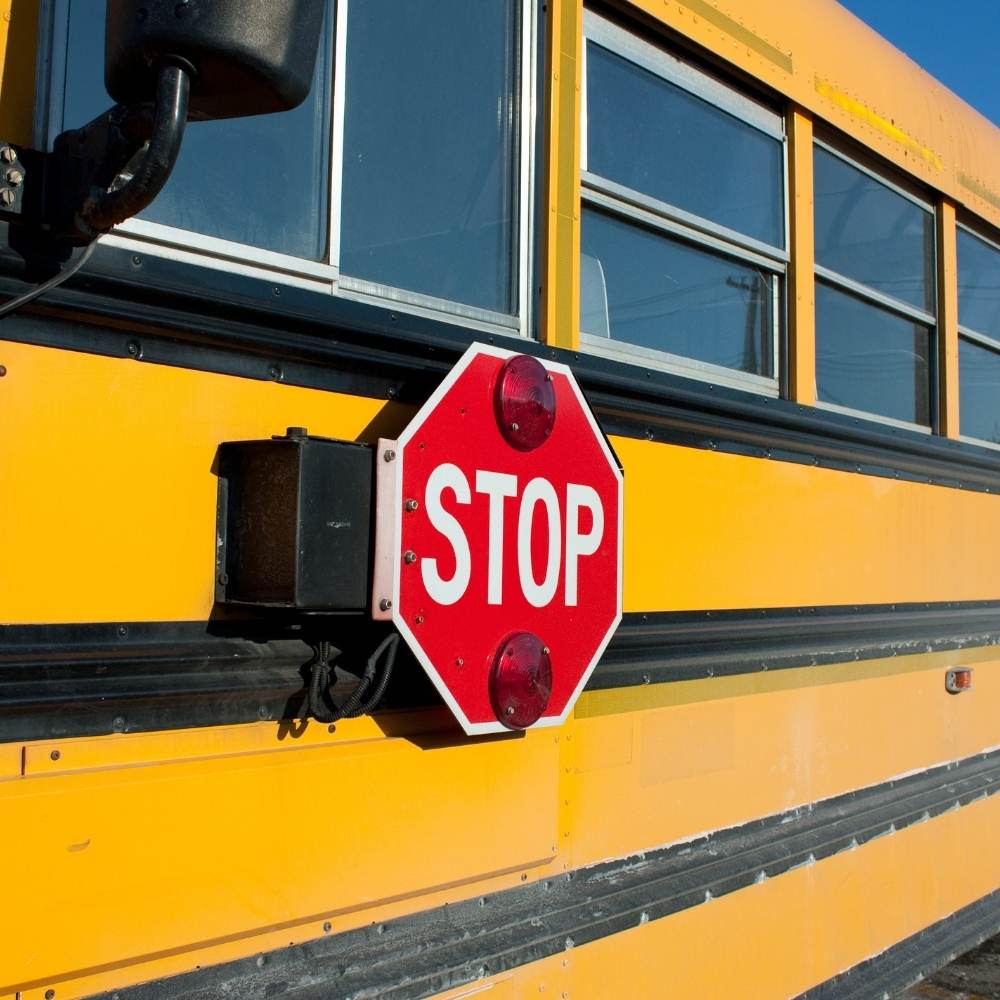
As part of this safety focus, we are providing daily safety tips for the week leading up to the opening day of school. Beginning Monday, August 29th, and running through Friday, September 2nd, our safety tips will focus on areas of risk and prevention, where staff can assess the hazard and implement corrective actions to keep themselves and their co-workers safe.
These tips will remind staff of the importance of safety, completing injury-free work, and maintaining a positive attitude throughout final preparations for opening day!
Safety Tip #1: School Workplace Injuries – How to Avoid Them
As the start of the school year is upon us, and your staff orientation process begins anew, it is a great time to review safety practices with school personnel. It’s essential to communicate the importance of safe work practices with staff. The basis of a good safety program is for staff to understand where injuries might occur and take proactive measures to avoid them whenever possible.
School district injuries occur most frequently from three sources: Slips, Trips, and Falls, Back Injuries from Lifting, and Struck/Hit by Student.
Tips for avoiding these causes of workplace injuries include:
- Avoid slips and falls by reviewing the environment (classroom) and removing any hazards which may pose a problem. Be sure to take precautions such as removing extension cords when not in use, removing worn or frayed carpeting, replacing damaged floor tiles, and providing space for walking around the desks and tables. Keep an eye out for boxes or debris during the first few days of school, especially during move-in periods.
- Back injuries often occur from unsafe lifting. Practice lifting techniques such as lifting with your legs, keeping your back straight, moving with your legs and not your back, and using mechanical means (cart, hand truck) for heavier items. Staff often take on too much moving and lifting during the classroom moving-in phase, causing back injuries, or creating other strain-type injuries.
- Struck/Hit by Student is a newer loss area for school employees and includes dealing with students in duress. Students under pressure often do not comply with verbal commands, and adults must intervene with a physical presence (to restrain not injure). Protect yourself when necessary and remove yourself from harm’s way if the situation becomes too dangerous. Get help as soon as it becomes apparent the problem is growing out of control. Maintaining lines of communication with others is vital to get help quickly.
Applying classroom housekeeping and lifting techniques helps remove hazards that lead to injuries. Now is a great time to remind all staff of the risks of injury and the importance of good housekeeping and hazard removal. Educate your school staff on maintaining a positive safety culture, and the school year will likely be an overwhelming success.
The Comp Alliance wishes all our school district members and employees a safe and prosperous 2022-2023 school year!
Safety Tip #2: Safe Lifting Techniques to Avoid Back Injuries
Training employees to ensure safety and security in the workplace is a school’s top priority. Since custodial work requires moving around extensive facilities and dealing with various hazards, any lack of control of the work environment promotes injuries. While these injuries are minor, they occur frequently.
About 1 out of every 96 employees sustain a nonfatal illness or injury that keeps them from performing their jobs. Learning how to bend, lift, and handle items throughout the day is essential for custodial teams in preventing injuries on the job.
Here are some easy steps they can follow to limit risks and improve janitorial safety.
- Widen feet for a more stable base.
- Bend your knees deeply before a lift.
- Engage your core muscles as you lift.
- Press down into your legs as you lift.
- Keep the load close to your body when possible.
- Ask for help if the object is heavy, awkward, or overhead.
When lifting and emptying buckets be sure to:
- Use floor drains if available.
- Use suitable lifting mechanics when emptying the buckets in a floor drain or sink.
Repeated lifting and carrying of loads increase the risk of back injury. Do not lift anything too heavy. Check the weight to be sure that you are comfortable with the lift.
- Use handles, cutouts, or handholds.
- Use carts with large wheels.
- Bend your knees and lift with your back straight.
- Plan the lift and talk to your partner.
- Use lifting equipment wherever possible.
Practicing lifting techniques will help to ensure that the school staff are safe. The Comp Alliance wishes all our school members a healthy and safe 2022-23 school year.
Safety Tip #3: Slips, Trips and Falls: A Loss Leader That Can Be Prevented
Slips, trips, and falls in schools result in strains, sprains, contusions, and fractures are the leading cause of employee injuries in school districts. Below are a few tips to help prevent slip, trip, and fall injuries.
Enforce good housekeeping procedures:
- Put away supplies/tools/equipment/papers when finished.
- Dispose of materials no longer being used.
- Encourage students to practice good housekeeping by keeping backpacks, coats, books, pencils/pens, and other belongings off the floor and out of walkways.
- Clean up spills immediately.
- Avoid carrying loads that are awkward or block your view.
- Observe and watch where you’re going.
- Watch for hazards such as backpacks, coats, books, binders, supplies, tools, equipment, electrical cords, and other items left in walkways.
During wet or wintery months, your school entryways must have carpets that extend at least six feet inside entrances. This simple measure will keep moisture from shoes to one manageable area and minimize the slip and fall risk throughout hallways and classrooms. Establishing a schedule to regularly maintain outdoor walkways, sidewalks, and doorways is one way to reduce slip and fall risk. Coordinating regular intervals for shoveling and salting is an easy method to prevent slips and falls. Inspecting your outdoor school property regularly for potential hazards is essential. For example, take a few minutes to identify pavement cracks or heaving. If you cannot repair them immediately, spray paint these hazards a bright color to visually focus the eyes and ensure safety for all school visitors. Whether it is a spill in the art room or a mess in the cafeteria, ensure your custodial staff is prepared to attend to these hazards by:
- Providing custodial staff with the necessary equipment and barricades to keep teachers and students away from slick floors.
- Ensuring custodial staff has ample cleaning and hazard removal supplies on hand.
Execute indoor safety inspections regularly. Educate all staff members on what to look for and solutions to help them prevent accidents. Staff members should identify and bundle any extension cords out of traffic areas and look for places where moisture can accumulate (classroom sinks and hallway fountains). Classroom storage is essential because improper storage methods can lead to a fall injury. Please encourage your students and staff to wear sensible, weather-safe shoes into the building when weather conditions permit and to change their shoes once they are safely indoors. Consider offering your staff members a shoe storage bag.
Adherence to routine, standard controls can reduce the potential for slip, trip, and fall injuries in school buildings. The Comp Alliance encourages all our school members to maintain safe facilities throughout the 2022-23 school year.
Safety Tip #4: Bloodborne Pathogen Exposures for Teachers and Custodians
Bloodborne pathogens are micro-organisms in human blood that can cause disease. Examples of infections caused by bloodborne pathogens include hepatitis B and HIV. These diseases can be passed from one person to another if exposed to a person's infected blood. There are many guidelines on avoiding or decreasing the risk of exposure to bloodborne pathogens, including annual training. Under OSHA's bloodborne pathogens standard, employers with exposure to blood or other potentially infectious materials (OPIM) must train employees annually regardless of the employees' prior training or education.
Even though not every school employee is occupationally exposed to bloodborne pathogens, it is still crucial for all employees to understand the dangers of infection and recognize safe practices to minimize their risk.
Workplace Transmission
- Special Education Area: Students are more prone to injury, may have special medical needs, and depend on adults for personal care.
- Classroom Settings: Exposures include student injuries, nose bleeds, and even paper cuts. Cleaning up blood creates exposure as well.
- Kitchen: Cuts from sharp objects, providing first-aid for an injured co-worker.
- Custodial Exposures: High-hazard, physical work where cuts and scrapes can occur routinely.
Accidental Injury
- Broken Glass
- Sharp metal
- Needles
- Knives
All teachers and staff must be cautious and protect themselves from a possible bloodborne pathogen transmission. Remember, if a staff member such as a teacher or custodian is possibly exposed to a bloodborne pathogen, you should:
- Wash the exposed area with soap and water and treat all potentially infectious material as if it was contagious. Finish the process with a hand sanitizer application.
- Routinely use appropriate barrier precautions to prevent skin and mucous membrane exposure when any patient's contact with blood or other body fluids is anticipated. Examples of protective controls include gloves, gowns, masks, and protective eyewear.
As a school employee, you must react to emergencies with your heart and your head. Know the facts and take precautions to protect yourself from bloodborne pathogen transmission.
Safety Tip #5: Safety Behind the Wheel
School district transportation departments have always had the vital job of safely getting students to and from school. The duties of a school bus driver are daunting. Many school transportation departments are faced with driver shortages requiring their own workarounds. Best practices cultivate a positive safety culture by enforcing safe driving procedures and encouraging positive attitudes.
Research shows that most accidents involving school buses occur in the Fall months. This is because, at the beginning of the school year, newer routes are learned, inexperienced drivers are behind-the-wheel, and students are learning their bus stop locations and procedures. Proper driver orientation should include job expectations, physical and mental fitness, and fatigue prevention. The driver-required Physical Performance Test is one identifier of a driver's physical wellness. Review the importance of each driver's mental state during the first few weeks of returning to school. Observe drivers, including seasoned ones, who experience stress and fatigue during this time. Dealing with new students can cause stress for some drivers too.
Safety behind the wheel for bus drivers includes:
- Drive defensively and expect the worst from other drivers. Many times, drivers will approach intersections and look to pull out in front of the bus, sometimes dangerously.
- Be alert to other drivers who may be unfamiliar with the traffic rules associated with approaching a stopped school bus and expect the worst from on-coming traffic. If you require children to cross in front of the bus, hold students until all required traffic has completely stopped.
- Come to work mentally prepared to take on the challenges of the position. Start with a good attitude and greet the children in a friendly tone. This has been known to get students to behave better on the bus.
- Know the safety procedures for the bus. If students are hurt, know how to use the first aid kit. If the bus is involved in an accident or breakdown, follow district procedures, and notify the bus garage personnel.
- Driving comfort corresponds with safe driving habits. Adjust your seat and mirrors to maintain good posture and viewing angles.
The Comp Alliance looks forward to working with our valued school district members throughout the 2022-23 school year. Have a safe and productive school year!
These tips will be emailed daily and available on our website www.compalliance.org.
Reach out to Robert Blaisdell, Director of Loss Control, for additional information, This email address is being protected from spambots. You need JavaScript enabled to view it., (518) 330-8591
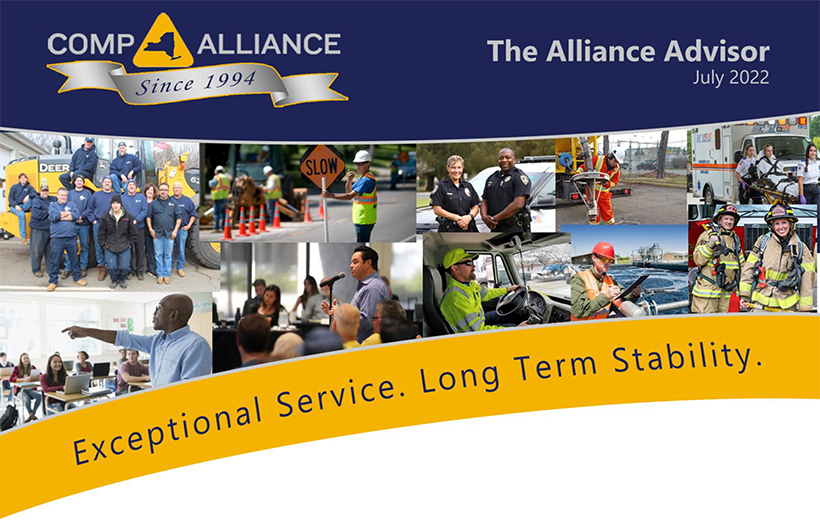
In This Issue
- The Comp Alliance Welcomes 8 New Members in June and July
- June and July Renewal Members to Receive Member Loyalty Award Checks
- Situational Awareness – The Foundation for Good Decision Making
- Legislative Update
- Introducing Bill Rabbitt, Our New Regional Marketing Representative
- Upcoming Virtual Training Seminars
- Featured Safety Source Topic – Slip, Trip, Fall Prevention
- Stay Informed
The Comp Alliance Welcomes 8 New Members in June and July
The Comp Alliance continued its steady growth for 2022 by adding eight new members to the program in June and July. We welcome the following new members to the program and look forward to working with all of you.
- Broome Tioga BOCES
- City of Long Beach VFD
- Oxford Academy CSD
- Town of Ellicottville
- Town of Elmira
- Town of Irondequoit
- Village of Hamburg
- Village of Springville
June and July Members to Receive Loyalty Award Checks
The Comp Alliance is pleased to announce an upcoming distribution of our Member Loyalty Award. In appreciation of those who have contributed to its continued success, the Comp Alliance will distribute a portion of its surplus to members. This special monetary award reflects recognition by the Board of Trustees of fiscal challenges faced by municipalities. The Member Loyalty Award provides a tangible benefit of municipal cooperation by returning funds to local governments and schools for the betterment of their communities.
All members who renewed with or joined the Comp Alliance in June and July will receive their Loyalty Award checks later this summer. Please keep an eye out for your checks in the mail during the 3rd quarter. Awarded amounts will be disbursed based on the individual member's longevity of membership with the Comp Alliance and its annual funding contribution.
The Comp Alliance is a not-for-profit workers' compensation group self-insurance program for municipalities and school districts. Focusing on improving workplace safety and providing stable funding for its members, the Alliance was formed in the early 1990s. New York Municipalities struggled to budget for unpredictable workers' compensation costs annually. The Comp Alliance offers its members budgetary stability and the opportunity to achieve significant savings by sharing the costs of workers' compensation insurance. Today, the Comp Alliance has over 330 members and more than $66 million in surpluses to help maintain long-term financial stability.
The Comp Alliance mission statement ensures members meet their long-term workers' compensation liabilities while maintaining stable funding contributions. With sponsorship by the Association of Towns of the State of New York and the New York State Conference of Mayors, the goals of the Comp Alliance remain the same.
Contact a Comp Alliance Marketing Manager or your insurance broker for more information on the Member Loyalty Award Program. Visit the Comp Alliance at www.compalliance.org for more details. Follow us on Twitter and Facebook for additional program enhancements and announcements.
Situational Awareness the Foundation for Good Decision Making
The week of June 19-25 was designated as National Safety Stand Down Week. This is a joint initiative of the International Association of Fire Chiefs (IAFC), the National Volunteer Fire Council (NVFC), the National Fire Protection Association (NFPA), and the Fire Department Safety Officers Association (FDSOA). The main objective was to promote safety training and awareness to fire departments. This year’s focus was on situational awareness as the foundation of good decision-making.
The practice of situational awareness can be applied to other aspects of municipal operations and was recently discussed during active shooter training for a municipal operation. The police instructor informed the audience to maintain situational awareness during workplace violence emergencies, as an approach to proper response. To address and maintain safety standards, this thought process can be utilized during town hall, highway, DPW, fire, police, and other operations too. This will also prove beneficial during emergency operations such as natural disasters, workplace violence, water/sewer breaks, fire response, and others.
To have situational awareness is to have a perception of the current environmental conditions, the comprehension of their meaning, and the projection of their future status. For municipal operations, it involves knowing what is going on around you at any given time and making proper safety decisions based on this knowledge. It is the foundation for sound decision-making.
With respect to workplace violence prevention, municipal staff can complete active shooter training and improve facility and employee safety through the establishment of safety procedures such as single points of entry, working in teams, installing office barriers, updating camera systems, and installing panic alarms. In addition to these controls, staff that maintains awareness around their workstations can better protect themselves and colleagues during hostile incidents. Understanding what might be happening and proper response (run, hide, fight) can save one’s life. In this way, the use of situational awareness can be helpful during workplace violence incidents.
Additional benefits of situational awareness include the completion of routine, but hazardous, work duties. It can help employees to identify deficiencies in the process and make corrections before injuries occur. Woodchippers and chainsaws can be the most dangerous equipment used by your municipal highway or DPW staff. Staff should be trained on the proper use of the equipment prior to use. This includes safety devices and appropriate Personal Protective Equipment (PPE) to be worn. Due to the hazards of operating this equipment, staff with situational awareness can prevent injuries. Precautions can be taken by avoiding too much brush from being placed in the chipper chute, improving footing while handling brush or felling trees, observing poor and changing weather conditions (rain, heat, cold), exchanging worn or missing PPE, replacing absent guards on equipment, or correct staff who might misuse equipment. These unsafe conditions can occur at any time during the operation and insightful employees can spot them and correct them before they lead to an injury.
Firefighters should practice situational awareness through training with experienced staff to focus on crucial aspects of given situations, knowing what distractions to avoid, listening to commands, and coordinating efforts.
Highway and DPW employees who observe operations, predict safe (or unsafe) outcomes, and maintain (or avoid/remove) them will be safer for their efforts. As an example, this summer might include a work zone setup. This will consist of planning the road site, what equipment is needed and available, understanding weather, soil and road conditions, expectations (good and bad) from the public, where to position employees, what PPE will be necessary, and how to react to traffic issues.
Conditions will vary throughout the duration of the work site. If your staff is able to comprehend these changes and respond safely to them it will help keep the area safe for workers and the community.
Situational awareness can also be helpful during other routine operations such as working with hazardous chemicals, driving, snowplow operations, outdoor work in the winter, parks and recreation work in summer, as well as office and administrative duties related to IT use. The ability to understand a changing work environment, predict what is likely to happen based on these conditions, and make decisions that keep yourself and co-workers safe can be applied to a variety of work responsibilities in municipal operations.
Situational awareness can be improved through experience and training. One key to safety is to make good, sound decisions based on the current circumstances. Not everyone makes good decisions all the time. With experience and training, it will be more likely that the correct decision will be made which keeps employees safe. Police officers who train on arrest techniques, CDL drivers who learn to drive defensively, water and sewer plant operators who know how to respond to a HAZWOPER incident, grounds crew who wear proper PPE while mowing and trimming, etc.
The variety of work completed for municipal operations present employees with continuously changing environments. These conditions provide opportunities for staff to observe and respond with varying degrees of success. Employees who are trained and gain experience in tackling these conditions exercise situational awareness resulting in error prevention, performance improvement, and injury reduction.
Legislative Update
Several bills amending workers’ compensation law recently passed both the New York State Assembly and the Senate. Three of these bills represent either an expansion of the compensability parameters under the New York workers’ compensation law or provide an increase in a benefit rate.
A.7178A / S.8271A increases the minimum compensation from $150 per week to one-fifth of the NYS Average Weekly Wage. This amounts to a minimum benefit of $318.91 per week through 2022, and jumps to $337.64 per week in 2023. While this would not affect most full-time employees of NYS municipalities and schools, it may have a sizable impact on the compensation rate for part time, seasonal, or summer workers. The bill also states that if the worker’s wage rate represents less than 1/5th of the statewide average weekly wage (to be reset at $1,688.19 per week as of 07/01/22), the employee would receive 100% of their wage rate while disabled.
Another bill, A.1118 / S.0768 defines “temporary, total disability” as “the injured employee's inability to perform his or her pre-injury employment duties or any modified employment offered by the employer that is consistent with the employee's disability” By defining “total, temporary disability” as it does, this bill poses a number of problems. First, there is concern among employers that the reference to “modified duty” could be interpreted to place a mandate on employers to offer modified duty to injured employees. While this is interpretation is not supported by the plain text of the law, it is stated to be the purpose of the law in the sponsor’s memo and justification, and will certainly be the interpretation advanced by claimants and their attorneys. A mandate of this nature may be impossible for many municipalities to comply with, as it risks violating collective bargaining agreements and civil service laws and rules that prohibit out-of-title work. In addition, by effectively nullifying “temporary, partial disability”, this bill has the potential to significantly increase costs to employers.
Lastly, A.2020A / S.6373 lowers the burden of proof for all employees to file claims for work-related stress. This bill extends to all workers the same benefit that was previously granted to first responders, firefighters, EMT workers, and police officers who encounter emergency situations that involve an extraordinary degree of stress. The bill eliminates the “work-related emergency” requirement that the mental health issue is caused by an unusual emergency would no longer be in effect, only that the causative event was extraordinary. Under this bill, the workers’ compensation board “may not disallow the claim upon a factual finding that the stress was not greater than that which usually occurs in the normal work environment.” Accordingly, the law creates a situation where a claim for “extraordinary stress” cannot be denied because it is ordinary stress common to work environment. It is expected that a vast number of these types of claims that were formerly disallowed by the Comp Board would now be allowed.
The overall impact of these bills would significantly increase the costs of workers’ compensation for all employers. If you are interested in learning more about these bills or how to communicate your position on them, we encourage you to reach out to your respective municipal association.
Introducing Bill Rabbitt, Our New Regional Marketing Representative
The Comp Alliance is excited to introduce a new Regional Marketing Representative, Bill Rabbitt. Bill comes to us having experience with a carrier and agencies in NY. He has previously managed sales and service for a workers’ compensation program. Bill is from the greater Albany area and looks forward to working with our members in the eastern portion of the state. Bill will be working with our existing agents and members, as well as prospective members of the Alliance. Bill will be reaching out soon and can be contacted at This email address is being protected from spambots. You need JavaScript enabled to view it. or 518-598-7198.
Upcoming Virtual Training Seminars
The Comp Alliance has several Live Virtual Video Conference Trainings scheduled for our members throughout the months of July and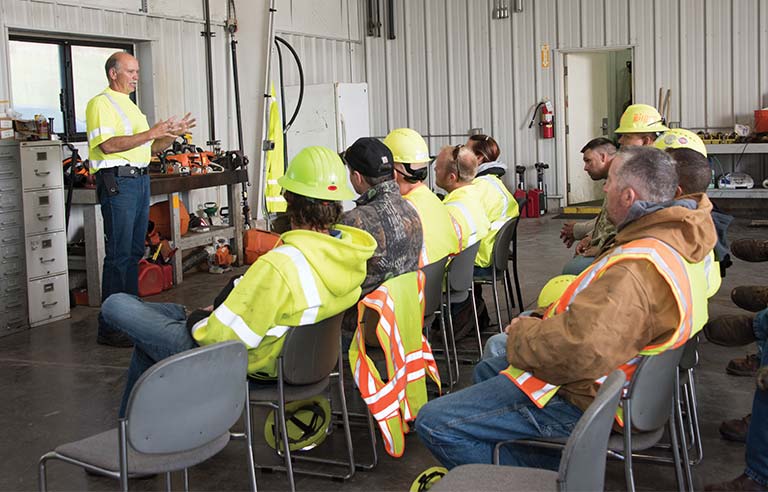 August.
August.
PESH-mandated topics of Workplace Violence, Right-To-Know – Chemical Safety, and Blood-Borne Pathogens will be covered.
Upcoming Schedule
7/18 - 10:00 a.m. - Noon
7/20 - 5:00 p.m. – 7:00 p.m.
7/25 - 10:00 a.m. - Noon
7/27 - 1:00 p.m. – 3:00 p.m.
8/1 - 10:00 a.m. - Noon
8/4 - 10:00 a.m. - Noon
8/8 – 10:00 a.m. - Noon
8/10 - 1:00 p.m. – 3:00 p.m.
8/15 – 10:00 a.m. – Noon
8/17 – 10:00 a.m. – Noon
8/22 – 10:00 a.m. – Noon
8/25 – 1:00 p.m. – 3:00 p.m.
8/29 – 10:00 a.m. - Noon
The Comp Alliance also has scheduled several virtual training programs covering the mandatory PESH-required topic of HAZWOPER. This awareness level seminar is required for municipal employees who may be the first upon a hazardous waste emergency on-site or off-site. Recommended for highway, department of public works, and water and sewer sanitation departments.
Upcoming HAZWOPER Schedule
7/21 - 8:00 a.m. - 8:30 a.m.
7/29 – 8:00 a.m. – 8:30 a.m.
8/12 – 8:00 a.m. – 8:30 a.m.
8/16 – 8:00 a.m. – 8:30 a.m.
8/29 – 8:00 a.m. – 8:30 a.m.
Email Robert Blaisdell at This email address is being protected from spambots. You need JavaScript enabled to view it. to register for any of these training sessions. Attendance is limited.
Please continue to check your email and the Comp Alliance website www.compalliance.org for additional dates later in the year.
Featured Safety Source Topic – Slip, Trip, Fall Prevention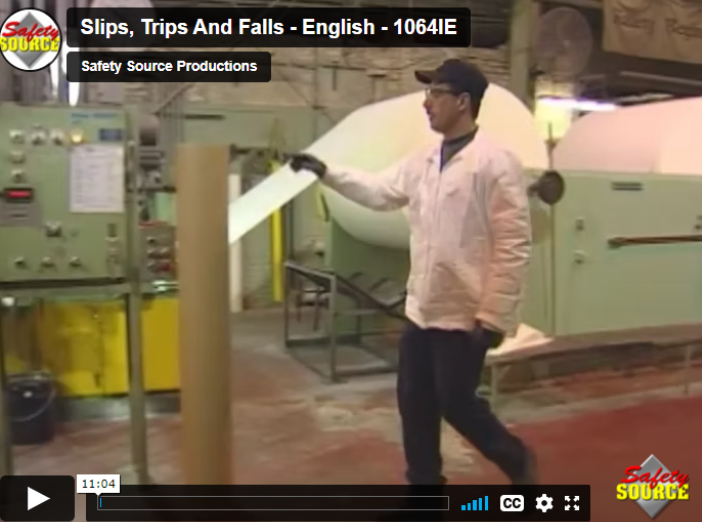
The Comp Alliance’s continued partnership with Safety Source, a leader in quality online safety training video content, has enabled many of our members to supplement and/or incorporate Safety Source videos into their safety training program. Safety Source is constantly adding to their video library and updating several topics that municipalities and school districts can utilize to train and educate their staff.
Slips, Trips, and Falls are one of the leading loss causes for our municipal and school members. Approximately 20% of national workers’ compensation claim costs are attributed to Slip, Trip, and Falls. Safety Source Video SS4164lE addresses the risk presented by slips, trips, and falls and steps you can take to reduce these preventable injuries from occurring.
The Safety Source Library is available by clicking here. If you are not yet registered for access to this diverse video library, please contact This email address is being protected from spambots. You need JavaScript enabled to view it.
The Comp Alliance strives to keep members informed of the latest industry and program news. Please visit us at www.compalliance.org for the latest news, updated events calendar, safety articles, safety bulletins and more.
Upcoming Events
| No events |

